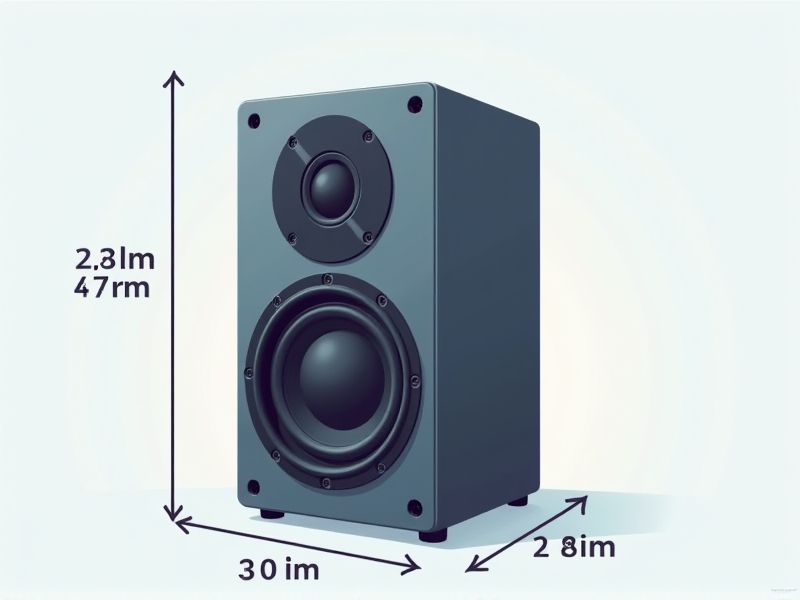
When selecting a speaker for your space, understanding standard dimensions can help ensure the right fit and optimal audio performance. Bookshelf speakers typically measure around 12 inches high, 7 inches wide, and 9 inches deep, making them suitable for most shelves or desktops. Floor-standing (tower) speakers, on the other hand, are generally larger--about 36 inches tall, 8-12 inches wide, and 10-16 inches deep--ideal for living rooms or home theaters. Always check the specific model's size before purchasing to make sure it matches your available space and aesthetic needs.
Woofer Diameter
The woofer diameter significantly influences the overall sound quality of a speaker, with common sizes ranging from 6.5 inches to 15 inches. A larger woofer typically provides enhanced bass response, delivering deeper and more resonant low frequencies. In contrast, smaller woofers, often around 5 inches, excel at producing clear midrange tones and higher frequencies. Selecting the appropriate woofer size for your audio needs can greatly enhance your listening experience, whether for home theater systems or professional audio setups.
Tweeter Diameter
The speaker standard for optimal audio performance typically emphasizes the importance of tweeter diameter, commonly ranging from 0.5 inches to 1.5 inches. A smaller tweeter diameter, such as 0.75 inches, delivers precise highs, making it ideal for detailed sound reproduction in genres like classical and acoustic music. Conversely, larger tweeters, often reaching 1.5 inches or beyond, can produce more robust sound in high-frequency ranges, beneficial for rock or electronic music. Selecting a tweeter with the appropriate diameter can significantly enhance your overall listening experience by accurately rendering the nuances of your favorite tracks.
Midrange Driver Size
The midrange driver size significantly impacts sound quality and clarity in speakers. Typically, midrange drivers range from 3 to 6.5 inches in diameter, effectively reproducing vocal and instrumental frequencies between 300 Hz and 3 kHz. A larger midrange driver often provides enhanced detail and a fuller sound, ideal for music and dialogue. When selecting a speaker, consider the midrange driver size to ensure your listening experience meets your expectations for clarity and richness.
Enclosure Volume
The enclosure volume of a speaker is crucial for optimal sound performance, typically ranging from 0.5 to 3 cubic feet, depending on the driver size and type. A larger enclosure volume can enhance low-frequency response, providing deeper bass, while a smaller volume may increase clarity and precision in the midrange frequencies. When designing your speaker's enclosure, consider the Thiele/Small parameters, which dictate how the driver interacts with the enclosure space. Proper alignment of these factors ensures that the speaker achieves efficient airflow and resonance, resulting in a more balanced audio output.
Speaker Height
The ideal height for a speaker often ranges between 5 to 7 feet, targeting optimal sound distribution in various environments. A height of 6 feet is commonly recommended, allowing for the audio to be directed at ear level for the majority of listeners. For venues with elevated ceilings, taller speakers can enhance acoustics by minimizing sound reflections. When placing speakers, ensure they are positioned away from walls to avoid interference, thereby improving clarity and depth of the sound.
Speaker Width
The standard width for speakers typically ranges from 5 to 12 inches, greatly influencing sound projection and clarity. A wider speaker can enhance bass output, allowing for deeper sound frequencies to resonate within your space. If your setup involves a home theater or larger room, consider speakers with widths over 10 inches for a fuller audio experience. For smaller spaces, you might opt for narrower speakers, optimizing your acoustic setup without overwhelming the area.
Speaker Depth
Speaker depth refers to the perceived distance from the listener to the sound source, significantly influencing audio quality and immersion. A well-designed speaker, typically featuring a depth of at least 12 inches, can create a fuller soundstage, allowing for clearer bass responses and more detailed midrange frequencies. In a setup prioritizing speaker depth, you can expect a richer listening experience, where both the placement of instruments and the depth of vocals are accurately represented. Key factors like room acoustics and speaker positioning can further enhance the effectiveness of speaker depth, ensuring optimal sound delivery in any environment.
Port Diameter
The port diameter of a speaker directly influences its acoustic performance and overall sound quality. A larger port diameter, typically ranging from 2 to 4 inches, can enhance airflow, reducing distortion and enabling deeper bass response. Conversely, a smaller port diameter, around 1 to 2 inches, may provide a tighter sound but can limit bass output. Understanding the relationship between port diameter and speaker efficiency is crucial for achieving your desired audio experience.
Faceplate Size
The faceplate size of a speaker significantly impacts its sound delivery and overall aesthetic. Typically measured in inches, faceplate dimensions commonly range from 4 inches to over 12 inches, affecting how sound is projected and the depth of bass. A larger faceplate often correlates with enhanced sound quality, allowing for a fuller range of frequencies and improved audio clarity. When choosing a speaker, consider how the faceplate size will fit within your space and meet your audio expectations.
Mounting Depth
Mounting depth is a critical specification when optimizing speaker performance, influencing both installation and sound quality. Commonly, a mounting depth of 2 to 6 inches is suitable for most vehicle audio systems, providing adequate space for components while ensuring clear sound reproduction. For home audio setups, deeper mounting depths can enhance bass response and overall clarity, with professional-grade speakers often exceeding 7 inches. When selecting a speaker for your home or vehicle, always verify the recommended mounting depth to achieve optimal acoustics and fit.
